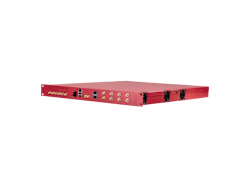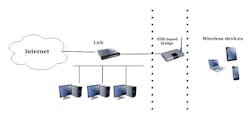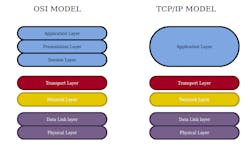Securing Networks Through Software-Defined Radio
Software-defined radio (SDR) is a flexible and high performance signal processing and radio communication system that employs certain software-based modules instead of traditional hardware-based modules. The modules of an SDR platform that are commonly implemented in software include filters, mixers, amplifiers, modulators and demodulators. The use of software-based components to accomplish certain functions in a radio communication system enhances its flexibility, reusability and cross-functionality.
SDR technology enables implementation of a variety of radio systems using a common platform architecture. Since software-based modules are reusable, the overall cost of developing and maintaining a software defined radio system is lower than that of a traditional radio system. The versatility and impressive performance of SDRs make them a suitable choice for a broad array of uses. This technology is ideal for various industries including health, telecommunication, aerospace, automotive and oil and gas. Vehicular networking and cognitive radio are classic examples of real-world applications of SDR technology.
SDR technology is advancing rapidly, and so is its popularity in use across different fields. One of the fields that has been significantly impacted by this technology is networking. The flexibility and performance of SDR technology makes it suitable for building dynamic, efficient and highly secure network components.
In traditional networks, dedicated hardware devices are used to interface wired and wireless networks. Hardware-based networking devices are a costly option because it is difficult to upgrade them. SDR technology allows implementation of network devices that can be upgraded without modifying existing hardware. The versatility of the SDR paradigm also allows smooth reconfiguration of networks and efficient spectrum access. In addition, its flexibility enables network devices to operate seamlessly on different communication protocols and frequencies.
SDR platforms can be broadly categorized into two classes: enthusiast grade and commercial grade SDRs. Enthusiast grade platforms are engineered to allow professionals and hobbyists to explore various facets of SDR technology and RF communication. One of the unique features of this class of SDRs is that their design is optimized to allow users to explore both the hardware and firmware aspects of radio systems. They are suitable for users who are interested in experimenting with modulation techniques, coding schemes, MIMO, Linux kernel drivers, and so on. BladeRf is a classic example of an enthusiast grade SDR platform (Figure 1).
Commercial grade SDR platforms are specially engineered to meet the evolving needs of today’s industries. The flexibility and programmability of these platforms allow industries to update or upgrade their systems without replacing existing hardware. Other features that make this technology an attractive option include impressive reliability, reusability of components and low cost of production and maintenance. The impressive performance of these SDRs make them an ideal choice for applications that demand high bandwidth and complex signal processing.
Per Vices is a reputable manufacturer of commercial grade SDR platforms and other RF solutions. Its customer-focused SDRs are designed to offer high bandwidth and flexibility and are ideal for a broad array of applications. In addition, Per Vices leading-edge SDR platforms are optimized to meet the challenging performance demands of today’s industrial applications. These platforms are suitable for use in broadcasting, defense, aerospace, medical, civil communication and so on.
Network setup (hardware perspective)
Software defined radio is one of the technologies that are changing the landscape of today’s networks. The SDR paradigm enables implementation of software-based modules that are flexible and easy to upgrade. This gradual transition from hardware-based network modules to software-based ones is revolutionizing both wired and wireless networks. The programmability of SDRs makes them ideal for the rapidly evolving network ecosystem.
SDR technology has the potential to enhance resource allocation and access, interoperability and upgradeability in both wireless and wired networks. Examples of network functionalities that can be implemented using the SDR paradigm include routers, firewalls and load balancers. In addition, this technology has the potential to transform the network security landscape (Figure 2).
The flexibility and reconfigurability of SDRs allows implementation of interoperable radio devices. These devices can serve as radio bridges and are suitable for joining two or more heterogeneous networks. SDRs for use in interconnecting networks employ frequency hopping among other techniques to ensure secure and uninterrupted communication.
Unlike traditional network devices, SDRs offer additional features that can help to protect networks against security threats. When properly utilized, techniques such as frequency hopping can help to boost the tolerance of networks against attacks. SDRs are versatile and can be programmed to broadcast below the noise floor. Employing this technique can help to further boost the resilience of software-based radio bridges against traditional attack mechanisms. In terms of security, SDR-based networking devices can offer better performance as compared to traditional hardware-based bridges.
Overview of a typical network (from a security standpoint)
There are two main communication system models: Transmission Control Protocol/ Internet Protocol (TCP/IP) model and Open System Interconnection (OSI) model. The TCP/IP communication model has five layers while the OSI model has seven layers. A communication system is considered safe when all its layers are secured (Figure 3).
The network layer is responsible for controlling and routing of data traffic within a network and is prone to a variety of threats. IP address spoofing is one of the major threats to the network layer. Network layer security is enhanced by employing anti-spoofing filters and firewalls.
The application layer is the topmost layer in the OSI’s 7 layer model and is highly exposed to security threats. When this layer is compromised, the attacker can access the other layers with minimum difficulty. When properly secured, this layer is capable of detecting malicious activity and handling sensitive information. Using authentication processes and high-level firewalls helps to enhance application layer security.
Today’s network security threats are sophisticated and advanced solutions are required to secure networks. Software-based solutions that are traditionally used to secure network infrastructure are no longer good enough. One promising solution to this performance gap is a reconfigurable hardware implementation whose architecture is based on the SDR paradigm.
An SDR-based defense system blends the parallelism of hardware and flexibility of software to provide a versatile and high performance network security solution. This security layer solution overcomes the inherent limitations of traditional security solutions and enables real-time implementation of complex defense functions. Field programmable gate arrays (FPGAs) are ideal for the implementation of this type of network security solution because they are reconfigurable and offer high parallelism.
Since network security threats are evolving everyday, security solutions are expected to have both dynamic and static update mechanisms. The flexibility and high performance of FPGAs make them suitable for implementing a broad array of security solutions including packet classification systems, protocol wrappers and intrusion detection systems. For such security applications, it is necessary to select an SDR platform that has sufficient hardware resources to accommodate future updates and additional functions.
The future of network security
Network defense systems are rapidly evolving to meet the needs of future network infrastructure. Security solutions that are based on reconfigurable hardware are increasingly replacing traditional solutions. The current trend is an indicator that the SDR technology will be at the core of the next generation security solutions.
As security threats become more sophisticated, more secure protocols and advanced encryption solutions are expected to replace traditional ones. The infrastructure of future networks requires building blocks that are both flexible and reconfigurable. The versatility and impressive performance of the SDR technology makes it an ideal choice for the implementation of future network encryption mechanisms and security protocols. In addition, the technology allows quick deployment of new innovations (Figure 4)
Today’s networks are susceptible to a broad array of security threats. Networks are rapidly evolving to ensure better performance, high fault tolerance capability and enhanced threat resilience. Mesh networks are designed to deliver improved performance and better tolerance to security threats.
Considering the sophistication of today’s security threats, mesh networks require advanced security measures and encryption mechanisms. The traditional approach of implementing these defense systems is not good enough for these advanced networks. The encryption and security needs of these advanced networks demand versatile and high performance platforms.
The SDR paradigm enables implementation of easy-to-upgrade FPGA-based functions. This technology is therefore suitable for use in the implementation of encryption and security features for mesh networks. Use of reconfigurable FPGAs guarantees impressive parallel performance and ensures cost-effective deployment of updates and new innovations.
With the SDR paradigm, it is possible to implement advanced hardware-based network layer and application layer security functions. Since FPGA-based security solutions are highly versatile, using this approach creates a window for future algorithm or architectural innovations. In addition, these SDR-based security solutions are superior when compared to traditional software-based solutions.





